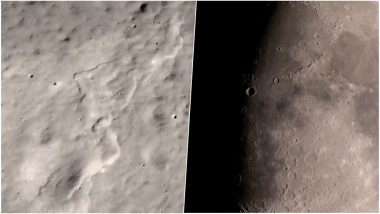While our planet earth is already in a disastrous state with the drastic change in climate, our satellite moon is also going through some fractures. According to a new study by NASA published this week in Nature Geosciences, the moon is slowly shrinking over time. The researchers used a new algorithm to reanalyze data from seismometers placed on the moon during several Apollo missions from 1969 to 1977. The findings reveal that the moon has shrunk. The moon's belt line has slimmed over 150 feet and it could be a result of a lot of moonquakes on the satellite. First Plant on Moon is Dead Already! Chinese Biological Experiment on the Moon Fails As Lunar Temperatures Drop to -170 Degrees.
The lunar surface is pushed together which causes moonquakes and faults on its surface. While the moon does not have tectonic plates like the planet earth, the tectonic activity loses its heat from its formation 4.5 billion years ago. So the surface wrinkles. The crust of the moon is brittle, thus the surface of the moon breaks down as the interior shrinks. These wrinkles are triggering moonquakes. NASA scientists compared the data they collected 2,000 photos taken by NASA's Lunar Reconnaissance Orbiter (LRO) since 2009 and determined the moon is 164 feet 'skinnier' than it was in the early 1970s. The lunar basin Mare Frigoris near the Moon's north pole, one of many vast basins which were considered dead sites from a geological point of view -- has been cracking and shifting. Moon May Have Harboured Life 4 Billion Years Ago.
Watch Video of NASA Explaining Moonquakes and Shrinking of The Moon:
The Moon is shrinking as its interior cools — causing its brittle surface to break, which produces moonquakes. 🌖〰️ Scientists combined data from four seismometers placed on the Moon by the Apollo astronauts with @LRO_NASA images to study these moonquakes: https://t.co/7A9dJ4mn4T pic.twitter.com/0FISDDONB1
— NASA Sun & Space (@NASASun) May 14, 2019
The tidal forces of the ocean waves on the earth also cause pressure on the satellite. The study mentions that six of the eight quakes occurred when the moon was at its farthest point from Earth, its apogee. The tidal forces add more stress on lunar faults. Renee Weber, a planetary seismologist at NASA's Marshall Space Flight Center confirmed that more exploration into the surface of the moon is necessary, to learn how moonquakes can be hazardous. "With a larger network of modern seismometers we could make huge strides in our understanding of the moon’s geology. This provides some very promising low-hanging fruit for science on a future mission to the moon," said co-author Nicholas Schmerr.
(The above story first appeared on LatestLY on May 15, 2019 09:00 AM IST. For more news and updates on politics, world, sports, entertainment and lifestyle, log on to our website latestly.com).













 Quickly
Quickly












